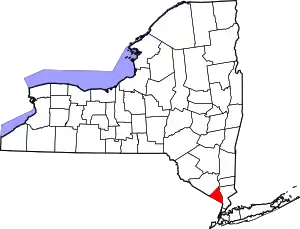South Nyack, New York
South Nyack is a village incorporated in 1878 in the town of Orangetown in Rockland County, New York, in the United States. It is located north of Grand View-on-Hudson, northeast of Orangeburg, east of Blauvelt State Park, south of Nyack and west of the Hudson River. The village is the western terminus of the Tappan Zee Bridge. Its population was 3,510 at the 2010 census.[3]
South Nyack, New York | |
|---|---|
 Location in Rockland County and the state of New York. | |
 South Nyack, New York Location within the state of New York | |
| Coordinates: 41°5′2″N 73°55′23″W | |
| Country | United States |
| State | New York |
| County | Rockland |
| Incorporated | 1878 |
| Government | |
| • Mayor | Bonnie R. Christian |
| • Deputy Mayor | Alain Leinbach |
| • Trustees | Andrew Goodwillie, Catherine McCue, and Nancy Willen |
| Area | |
| • Total | 1.68 sq mi (4.36 km2) |
| • Land | 0.60 sq mi (1.56 km2) |
| • Water | 1.08 sq mi (2.79 km2) |
| Elevation | 72 ft (22 m) |
| Population (2010) | |
| • Total | 3,510 |
| • Estimate (2019)[2] | 3,316 |
| • Density | 5,490.07/sq mi (2,121.35/km2) |
| Time zone | UTC-5 (Eastern (EST)) |
| • Summer (DST) | UTC-4 (EDT) |
| ZIP code | 10960 |
| Area code(s) | 845 |
| FIPS code | 36-69441 |
| GNIS feature ID | 0965828 |
| Website | southnyack.ny.gov |

History
Following the extension of the Northern Branch of The New Jersey Railroad into the area in the mid-19th century, rapid growth ensued. Town government no longer being seen as an effective means of dealing with the area's needs, village incorporation was discussed. Fearing higher taxes, those in what would have become the northern part of Nyack village formed their own municipal corporation first, named Upper Nyack. Nyack village still incorporated, although without this northern portion. Residents in the southern part of Nyack village, however, soon became dissatisfied with the notion of paying taxes that more heavily benefitted the rest of the village. After succeeding in dissolving Nyack's corporation, the southern portion of the former village incorporated as the village of South Nyack. The area between Upper Nyack and South Nyack was reincorporated thereafter, again as Nyack.[4]
On December 17, 2020, residents voted 508-292 to dissolve the village in favor of becoming an unincorporated area within the town of Orangetown.[5][6] The dissolution vote does not take immediate effect, and in the meantime the village continues to exist.[7]
Geography
According to the United States Census Bureau, the village has a total area of 1.7 square miles (4.4 km2), of which 0.6 square miles (1.6 km2) is land and 1.1 square miles (2.8 km2), or 63.31%, is water. South Nyack is located adjacent to the Hudson River.
The New York State Thruway (Interstate 87) passes through the village after passing over the Tappan Zee Bridge.
Demographics
| Historical population | |||
|---|---|---|---|
| Census | Pop. | %± | |
| 1890 | 1,496 | — | |
| 1900 | 1,601 | 7.0% | |
| 1910 | 2,068 | 29.2% | |
| 1920 | 1,799 | −13.0% | |
| 1930 | 2,212 | 23.0% | |
| 1940 | 2,093 | −5.4% | |
| 1950 | 3,102 | 48.2% | |
| 1960 | 3,113 | 0.4% | |
| 1970 | 3,435 | 10.3% | |
| 1980 | 3,602 | 4.9% | |
| 1990 | 3,352 | −6.9% | |
| 2000 | 3,473 | 3.6% | |
| 2010 | 3,510 | 1.1% | |
| 2019 (est.) | 3,316 | [2] | −5.5% |
| U.S. Decennial Census[8] | |||
As of the census[9] of 2000, there were 3,473 people, 1,201 households, and 690 families residing in the village. The population density was 5,665.0 people per square mile (2,198.3/km2). There were 1,258 housing units at an average density of 2,052.0 per square mile (796.3/km2). The racial makeup of the village was 71.32% White, 16.04% African American, 0.20% Native American, 5.79% Asian, 0.03% Pacific Islander, 2.39% from other races, and 4.23% from two or more races. Hispanic or Latino of any race were 6.91% of the population.
There were 1,201 households, out of which 26.9% had children under the age of 18 living with them, 45.1% were married couples living together, 9.2% had a female householder with no husband present, and 42.5% were non-families. 31.3% of all households were made up of individuals, and 8.4% had someone living alone who was 65 years of age or older. The average household size was 2.43 and the average family size was 3.10.
In the village, the population was spread out, with 18.3% under the age of 18, 20.5% from 18 to 24, 29.7% from 25 to 44, 20.8% from 45 to 64, and 10.8% who were 65 years of age or older. The median age was 32 years. For every 100 females, there were 94.8 males. For every 100 females age 18 and over, there were 89.3 males.
The median income for a household in the village was $53,000, and the median income for a family was $62,262. Males had a median income of $45,735 versus $39,850 for females. The per capita income for the village was $26,135. About 6.2% of families and 8.9% of the population were below the poverty line, including 8.4% of those under age 18 and 10.8% of those age 65 or over.
Tourism
Historical markers


- Carson McCullers House – 131 South Broadway – (NRHP)
- Ross-Hand Mansion – 122 South Franklin Street - (NRHP)
- Joseph Cornell House - 137 South Broadway
Landmarks and places of interest
- Nyack College – Established 1897 by Dr. A.B. Simpson as the "Missionary Training Institute". It is considered to be the first school of its kind in North America. Simpson Hall, built 1897, is believed to be one of the oldest wooden institutional structures and largest the Victorian structure in the Hudson Valley.
- St. Paul’s United Methodist Church – 134 South Broadway at Division Avenue
Other sites of interest
The Nyack Ice House, formerly located at 90 Clinton Avenue, which opened in 1881, producing and delivering blocks of ice to homes, restaurants, bars and stores, was demolished on April 2 and 3, 2008. During the 19th century, the Nyack Ice House was the only ice plant between Englewood, New Jersey and Newburgh, New York. When sold in 1921, production of coal and later oil began at the site and the name changed to "Nyack Ice and Coal Co." In 1965, the business also sold milk and was operated under the original name. Recently, the company sold mostly to ice carvers and supermarkets and supplied the ice for magician David Blaine's stunt in 2000 when he suspended himself in a block of ice over Times Square.
Orangetown Fire Company No. 1, located at 90 Depot Place, was founded in 1834 and was Rockland County's first fire company. Today it is one of eight components of the Nyack Fire Department. The company was unofficially formed in 1832 with 16 members and was organized in 1834. The company still holds in its possession its first apparatus, which dates back to 1749 and survived a fire in the firehouse some years ago. The Orangetown Fire Company No. 1 also serves Upper Nyack and Nyack.
Transportation
The Village of South Nyack is the western terminus of the Tappan Zee Bridge, which connects the village to Tarrytown in Westchester County. The village is served by the New York State Thruway (in its section concurrent with Interstate 87 and Interstate 287) at Exit 10 (westbound only). Another important arterial roadway serving the village is U.S. Route 9W.
South Nyack was formerly served by the Northern Branch of the Erie Railroad, with service to Pavonia Terminal in Jersey City.[10] The village had its station near the corner of Broadway and Cornelison Avenue. Passenger service was discontinued in 1966, and the right-of-way has been converted into the Raymond G. Esposito Trail.[11]
Today, South Nyack is served by Tappan ZEExpress, a bus service operated by Transport of Rockland. Tappan ZEExpress buses connect South Nyack's bus stop at Broadway & Clinton Avenue to rail stations in Tarrytown, White Plains, Spring Valley, and Suffern.[12] South Nyack is also served by Rockland Coaches/Red and Tan Lines Buses (operated by Coach USA) to the Port Authority Bus Terminal and George Washington Bridge Bus Terminal in New York City.[13]
Notable people
- Carson McCullers, novelist, playwright, and poet.[14]
- Rosie O'Donnell, comedian and LGBT activist.[15]
- Arthur Zegart (1916-1989), American documentary film producer.[16]
Footnotes
- "2019 U.S. Gazetteer Files". United States Census Bureau. Retrieved July 27, 2020.
- "Population and Housing Unit Estimates". United States Census Bureau. May 24, 2020. Retrieved May 27, 2020.
- "Profile of General Population and Housing Characteristics: 2010 Demographic Profile Data (DP-1): South Nyack village, New York". United States Census Bureau. Retrieved February 6, 2012.
- "Nyack to be Incorporated: A majority of citizens vote for the project" (PDF). The New York Times. February 28, 1883. Retrieved June 18, 2009.
- "South Nyack Votes to Dissolve". Nyack News & Views. December 18, 2020. Retrieved December 18, 2020.
- "South Nyack residents vote to dissolve the village government". lohud.com. December 18, 2020. Retrieved December 18, 2020.
- "What's next for South Nyack after residents vote to dissolve village government". lohud.com. December 18, 2020. Retrieved January 7, 2021.
- "Census of Population and Housing". Census.gov. Retrieved June 4, 2015.
- "U.S. Census website". United States Census Bureau. Retrieved January 31, 2008.
- New York Times article
- Esposito Trail
- Tappan ZEExpress Bus Schedule
- Rockland Coaches Schedule
- New York SP McCullers, Carson, House at the National Archives and Records Administration
- South Nyack's Rosie O'Donnell Welcomes Baby Girl - Opinion | Nyack-Piermont, New York Patch Retrieved 2014-09-12.
- "Arthur Zegart: director, producer, writer". The Journal News. White Plains, New York. February 5, 1989. p. 16. Retrieved November 25, 2018 – via Newspapers.com.
